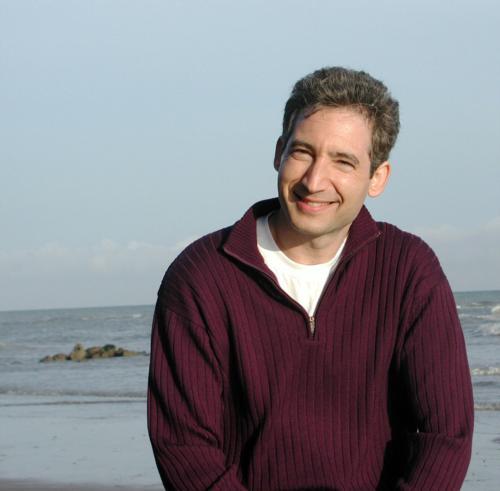
News
Cambridge Residents Slam Council Proposal to Delay Bike Lane Construction

News
‘Gender-Affirming Slay Fest’: Harvard College QSA Hosts Annual Queer Prom

News
‘Not Being Nerds’: Harvard Students Dance to Tinashe at Yardfest

News
Wrongful Death Trial Against CAMHS Employee Over 2015 Student Suicide To Begin Tuesday

News
Cornel West, Harvard Affiliates Call for University to Divest from ‘Israeli Apartheid’ at Rally
Class of 1984: Brian R. Greene
The Elegant Physicist

Perhaps drawing inspiration from Isaac Newton, when physicist Brian R. Greene ’84 worked deep into the night on classical mechanics homework as an undergraduate, he routinely consumed upwards of 15 apples in a single sitting, courtesy of the dining hall.
Greene’s unusual eating habits were legendary among his Winthrop housemates. They also belied a compulsive nature, one that propelled Greene to the forefront of theoretical physics. He is also lauded outside the academic realm for his two bestsellers, “The Elegant Universe” and “Fabric of the Cosmos,” which brought esoteric concepts of string theory to the masses.
Theoretical physicists are rarely household names, yet “The Elegant Universe” worked its way to number four on the New York Times Best-Seller List. The book was eventually made into a PBS miniseries, narrated by Greene. Now a tenured professor at Columbia University, Greene has taught applications of quantum mechanics to a spectrum of students ranging from budding Harvard physicists to comedian Stephen Colbert.
CHILD’S PLAY
Greene’s enthusiasm for mathematics began early. The physicist said that by the seventh grade, he had “maxed out” on the coursework his school had to offer. Greene’s teacher sent him knocking on doors at Columbia in search of a professor willing to teach him.
“[The note] basically said, ‘Help this kid learn some stuff, he’s beyond what we can do,’” Greene recalled. He found a teacher in the math department who agreed to take him on, and the two met three times a week until his high school graduation.
“That’s where the interest really flourished,” Greene said. “I was able to keep going on at a pace that felt right, rather than a pace that the school was offering.”
Greene was treading uncharted academic territory in his family. His father dropped out of high school and his mother did not finish college. Though his father lacked formal education, Greene said, he was very intellectual and was “captivated by ideas.”
Greene’s older brother left the University of Wisconsin to follow the Hare Krishna movement. Despite their different paths, Greene said his brother’s interests are very similar to his own.
“We both ask the big questions, but he looks at it from a very different point of view.”
HOME AT HARVARD
Though Greene originally chose Princeton over Harvard, in the summer before his freshman year he started to doubt that Princeton’s pastoral setting was ideal for a teenager used to the bustle of New York City. Weeks before school began, Greene called a Harvard dean and asked for his spot back.
Harvard gave him just one week to accept, and this time, Greene was certain he made the right choice.
Eero P. Simoncelli ’84, Greene’s roommate of three years, insisted that in college he and Greene were not stereotypical physics nerds—they showered regularly—and though they were not “party animals,” they were pretty social in college.
“We both worked pretty hard but we both played pretty hard too,” Simoncelli said.
Simoncelli also recalled devoting entire weekends—Friday after dinner until early Monday morning—to problem sets for a particularly difficult course in their junior year. He adds that though the two were very studious, they had interests outside of physics.
Greene was active in the Harvard theater scene as an actor. According to Simoncelli, Greene’s interest in the arts may have been inspired by his father—a bass player and vocal coach who had taught Harry Belafonte.
Though it always was clear that Greene would be an important physicist, it was this interest in theater, Simoncelli suggested, that may have foreshadowed his later entree in the popular science arena.
“He loved being on stage when he did those shows,” he said. “I think when he became a scientist, he started giving talks and realized how much he enjoyed it.”
DOWN TO A SCIENCE
Just as he roamed the halls in search of a willing mentor in the seventh grade, Greene said he would “unabashedly knock on professors’ doors” at Harvard. He asked astrophysics professor James M. Moran if he could conduct research in his lab. Moran was surprised at the time that a physics student would seek out research in astronomy. “We are up here in the observatory—it’s rare to have a physics kid tramping through looking for projects, at least back then,” he said.
Though Moran said it was a bit unusual to give a project to an undergraduate, he was willing to take Greene on.
Twenty-five years later, Moran still recalls Greene’s extraordinary proficiency in computer programming.
“Nowadays people can use established programs,” Moran said. “He did everything from scratch and did the programming to make it work.”
Even though Greene’s talents were notable, Moran had no idea that his student would garner such acclaim. “He was just a very smart Harvard undergraduate,” Moran said. “I was doing lots of stuff back then, I didn’t really recognize the gem he was.”
—Staff writer Laura G. Mirviss can be reached at lmirviss@fas.harvard.edu.
Want to keep up with breaking news? Subscribe to our email newsletter.
